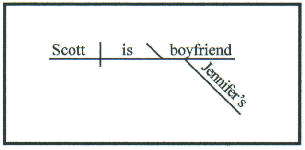| |
Diagramming Sentences
Sentence Diagrams
~ One Way of Learning
English Grammar ~
The Basics of Sentence
Diagramming
~ Sentences 31-35 ~
|
| |
| Dear
Visitor: If you have a question about any of my sentence diagrams, please
write to ermoutoux@juno.com.
I will try to answer your question promptly. |
| |
|
Sentence 31: The parents
ate the cake, and the children ate the cookies.
|
 |
A compound sentence
consists of two or more main clauses (clauses that are able to
stand alone if necessary), often joined by a coordinating
conjunction (usually and, or, or but).
In a sentence diagram, one arranges the clauses from top to bottom
according to their position in the sentence. The absence of a
coordinating conjunction can be shown with an x. |
|
|
Sentence 32: We are
staying home tonight because we have too much homework.
|
 |
A complex sentence contains a
main clause and a subordinate clause; the latter cannot
stand alone. The subordinating conjunction, in this sentence the
word because, is placed on a broken diagonal line that
runs from the main verb down to the verb of the subordinate
clause. |
|
|
Sentence 33: Although he
was aware of the big game, the math teacher assigned enough work for a
week.
|
 |
| Even when the subordinate
clause (sometimes called dependent clause) comes first, it is
diagrammed below the main clause (sometimes called the independent
clause). Like because in the previous sentence, although
is a subordinating conjunction; others are since, while, after, if,
unless, and so that. Subordinate clauses introduced by
subordinating conjunctions are called adverbial clauses. Note:
the prepositional phrase for a week modifies the
attributive adjective enough. |
|
Sentence 34: Sue left
school early because she felt sick, but her mother brought her back
because she had forgotten her Latin book.
|
 |
| If a sentence
contains two or more main clauses and at least one subordinate clause,
it is called a compound-complex sentence. In the sentence above,
the coordinating conjunction is but, and the subordinating
conjunction (used twice) is because. |
| Sentence 35:
Scott is Jennifer's boyfriend. |
|
 |
The possessive case
is used to show 1) possession or belonging to (Jennifer's boyfriend),
2) the subject (agent) of an action (the king's departure), 3)
the object of an action (the town's destruction), and 4)
description (three months' pay). A possessive is placed on a
slanted line below the noun to which it pertains. |
| Return
to Basics of Sentence Diagramming, Part Two |
| Return to
Sentence Diagrams, page 1 |
| Return to
German, Latin, English |
| |




